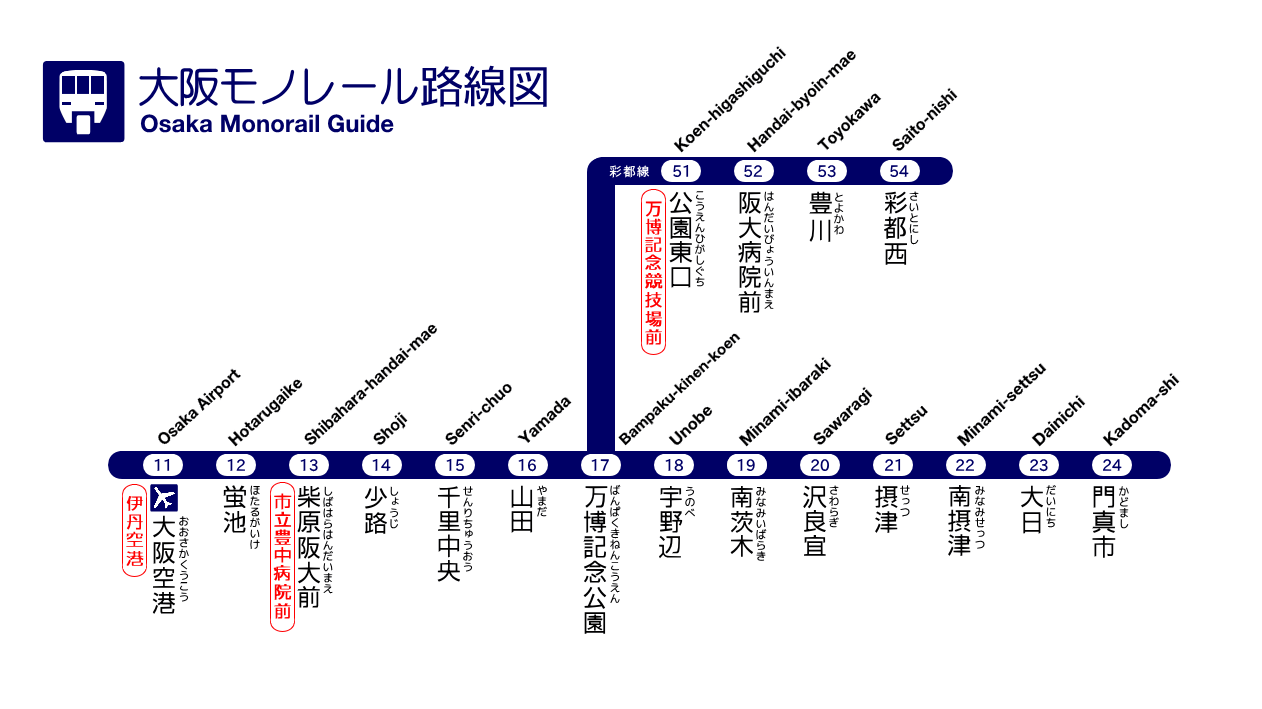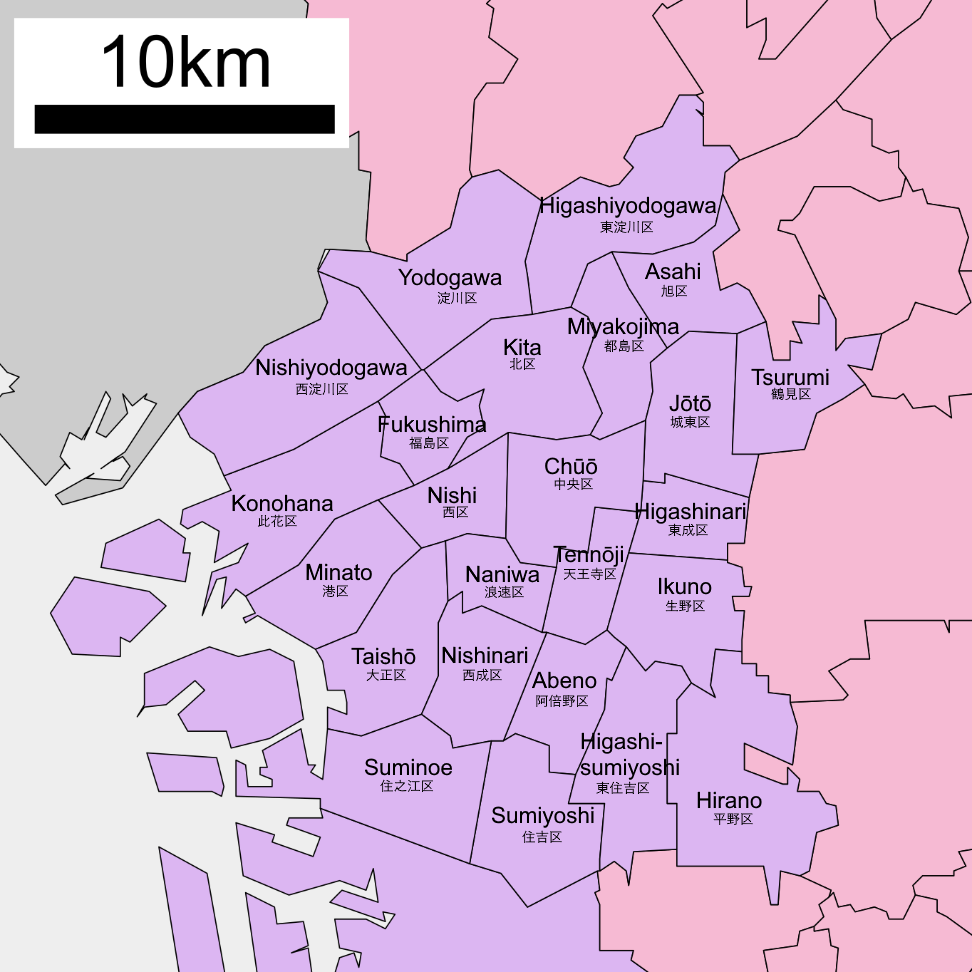|
Toyokawa Station (Osaka)
is a monorail station on the Osaka Monorail located in Ibaraki, Osaka, Japan. Lines *Osaka Monorail Saito Line (Station Number: 53) History *March 19, 2007 – Station begins operation as the Saito Line extension from Handai-byoin-mae to Saito-nishi opens Layout There is an island platform An island platform (also center platform, centre platform) is a station layout arrangement where a single platform is positioned between two tracks within a railway station, tram stop or transitway interchange. Island platforms are popular on ... with two tracks. Adjacent stations Ibaraki, Osaka Osaka Monorail stations Railway stations in Japan opened in 2007 {{Osaka-railstation-stub ... [...More Info...] [...Related Items...] OR: [Wikipedia] [Google] [Baidu] |
Osaka Monorail Toyokawa Station
is a designated city in the Kansai region of Honshu in Japan. It is the capital of and most populous city in Osaka Prefecture, and the third most populous city in Japan, following Special wards of Tokyo and Yokohama. With a population of 2.7 million in the 2020 census, it is also the largest component of the Keihanshin Metropolitan Area, which is the second-largest metropolitan area in Japan and the 10th largest urban area in the world with more than 19 million inhabitants. Osaka was traditionally considered Japan's economic hub. By the Kofun period (300–538) it had developed into an important regional port, and in the 7th and 8th centuries, it served briefly as the imperial capital. Osaka continued to flourish during the Edo period (1603–1867) and became known as a center of Japanese culture. Following the Meiji Restoration, Osaka greatly expanded in size and underwent rapid industrialization. In 1889, Osaka was officially established as a municipality. The constructi ... [...More Info...] [...Related Items...] OR: [Wikipedia] [Google] [Baidu] |
Monorail
A monorail (from "mono", meaning "one", and "rail") is a railway in which the track consists of a single rail or a beam. Colloquially, the term "monorail" is often used to describe any form of elevated rail or people mover. More accurately, the term refers to the style of track.The term "track" is used here for simplicity. Technically the monorail sits on or is suspended from a guideway containing a singular structure. There is an additional generally accepted rule that the support for the car be narrower than the car. Etymology The term possibly comes from 1897, from German engineer Eugen Langen, who called an elevated railway system with wagons suspended the '' Eugen Langen One-railed Suspension Tramway'' (Einschieniges Hängebahnsystem Eugen Langen). Differentiation from other transport systems Monorails have found applications in airport transfer and medium capacity metros. To differentiate monorails from other transport modes, the Monorail Society defines a monorail ... [...More Info...] [...Related Items...] OR: [Wikipedia] [Google] [Baidu] |
Osaka Monorail
The is a monorail system in northern Osaka Prefecture, Japan, operated by . At long, it is the second longest monorail system in the world after the Chongqing Monorail and the longest monorail system in Japan. It links the three campuses of Osaka University. Lines Rolling stock Current * 1000 series * 2000 series * 3000 series File:Osaka_Monorail_1624_at_Handai-byoin-mae_Station.jpg, 1000 series File:Osaka_Monorail_2111_at_Sawaragi_Station.JPG, 2000 series File:Osaka_Monorail_3650_at_Toyokawa_Station.jpg, 3000 series Extension In 2015, Osaka Prefecture announced plans to extend the monorail to Uryudo in Higashiōsaka. See also *Monorails in Japan *List of rapid transit systems These lists of rapid transit systems are sorted by the type of system: * List of tram and light rail transit systems * List of town tramway systems * Medium-capacity rail transport system * List of premetro systems * List of metro systems * List of ... References External links * {{Rapi ... [...More Info...] [...Related Items...] OR: [Wikipedia] [Google] [Baidu] |
Ibaraki, Osaka
is a city in Osaka Prefecture, Japan. It is a suburban city of Osaka City and a part of the Kyoto-Osaka-Kobe metropolitan area. Ibaraki translates to "wild trees" or "thorny trees". The city was incorporated on 1 January 1948. As of February 2017, the city has an estimated population of 280,562 and a population density of 3,580 persons per km2. The total area is 76.52 km2. Transportation Railways *West Japan Railway Company **JR Kyoto Line: Ibaraki Station– JR-Sōjiji Station *Hankyu Railway **Hankyu Kyoto Line: Minami-Ibaraki Station–Ibaraki-shi Station– Sōjiji Station *Osaka Monorail **Main Line: Unobe Station– Minami-Ibaraki Station– Sawaragi Station **Saito Line Handai-byōin-mae Station– Toyokawa Station–Saito-nishi Station Highways * * Education Prefectural public senior high schools: * * * * * * Private junior and senior high schools: * * * * Korea International School, a Korean international junior and senior high school, is in Ibaraki ... [...More Info...] [...Related Items...] OR: [Wikipedia] [Google] [Baidu] |
Osaka
is a designated city in the Kansai region of Honshu in Japan. It is the capital of and most populous city in Osaka Prefecture, and the third most populous city in Japan, following Special wards of Tokyo and Yokohama. With a population of 2.7 million in the 2020 census, it is also the largest component of the Keihanshin Metropolitan Area, which is the second-largest metropolitan area in Japan and the 10th largest urban area in the world with more than 19 million inhabitants. Osaka was traditionally considered Japan's economic hub. By the Kofun period (300–538) it had developed into an important regional port, and in the 7th and 8th centuries, it served briefly as the imperial capital. Osaka continued to flourish during the Edo period (1603–1867) and became known as a center of Japanese culture. Following the Meiji Restoration, Osaka greatly expanded in size and underwent rapid industrialization. In 1889, Osaka was officially established as a municipality. The construc ... [...More Info...] [...Related Items...] OR: [Wikipedia] [Google] [Baidu] |
Japan
Japan ( ja, 日本, or , and formally , ''Nihonkoku'') is an island country in East Asia. It is situated in the northwest Pacific Ocean, and is bordered on the west by the Sea of Japan, while extending from the Sea of Okhotsk in the north toward the East China Sea, Philippine Sea, and Taiwan in the south. Japan is a part of the Ring of Fire, and spans Japanese archipelago, an archipelago of List of islands of Japan, 6852 islands covering ; the five main islands are Hokkaido, Honshu (the "mainland"), Shikoku, Kyushu, and Okinawa Island, Okinawa. Tokyo is the Capital of Japan, nation's capital and largest city, followed by Yokohama, Osaka, Nagoya, Sapporo, Fukuoka, Kobe, and Kyoto. Japan is the List of countries and dependencies by population, eleventh most populous country in the world, as well as one of the List of countries and dependencies by population density, most densely populated and Urbanization by country, urbanized. About three-fourths of Geography of Japan, the c ... [...More Info...] [...Related Items...] OR: [Wikipedia] [Google] [Baidu] |
Osaka Monorail Saito Line
is the monorail route of the Osaka Monorail which runs from in Suita, Osaka Prefecture to Saito-nishi Station. The line opened in two stages - on 1 October 1998, from Bampaku-kinen-koen Station to Handai-byoin-mae Station, and on 19 March 2007, to Saito-nishi Station, in Ibaraki, about a kilometer from the Osaka University of Foreign Studies in Minoh is a city in northwestern Osaka Prefecture, Japan. Its name is commonly romanized as "Minō" or "Minoo"; however, the city government officially uses the spelling Minoh in English. As of October 2016, the city has an estimated population of 134 .... The branch is long. An extension was planned north of Saito-nishi Station, but plans were dropped on 27 January 2017 due to a lack of profitability as the zoning around the proposed extension was switched from residential to industrial. Stations External linksOfficial website [...More Info...] [...Related Items...] OR: [Wikipedia] [Google] [Baidu] |
Island Platform
An island platform (also center platform, centre platform) is a station layout arrangement where a single platform is positioned between two tracks within a railway station, tram stop or transitway interchange. Island platforms are popular on twin-track routes due to pragmatic and cost reasons. They are also useful within larger stations where local and express services for the same direction of travel can be provided from opposite sides of the same platform thereby simplifying transfers between the two tracks. An alternative arrangement is to position side platforms on either side of the tracks. The historical use of island platforms depends greatly upon the location. In the United Kingdom the use of island platforms is relatively common when the railway line is in a cutting or raised on an embankment, as this makes it easier to provide access to the platform without walking across the tracks. Advantages and tradeoffs Island platforms are necessary for any station with many th ... [...More Info...] [...Related Items...] OR: [Wikipedia] [Google] [Baidu] |
Osaka Monorail Stations
is a designated city in the Kansai region of Honshu in Japan. It is the capital of and most populous city in Osaka Prefecture, and the third most populous city in Japan, following Special wards of Tokyo and Yokohama. With a population of 2.7 million in the 2020 census, it is also the largest component of the Keihanshin Metropolitan Area, which is the second-largest metropolitan area in Japan and the 10th largest urban area in the world with more than 19 million inhabitants. Osaka was traditionally considered Japan's economic hub. By the Kofun period (300–538) it had developed into an important regional port, and in the 7th and 8th centuries, it served briefly as the imperial capital. Osaka continued to flourish during the Edo period (1603–1867) and became known as a center of Japanese culture. Following the Meiji Restoration, Osaka greatly expanded in size and underwent rapid industrialization. In 1889, Osaka was officially established as a municipality. The constructi ... [...More Info...] [...Related Items...] OR: [Wikipedia] [Google] [Baidu] |





